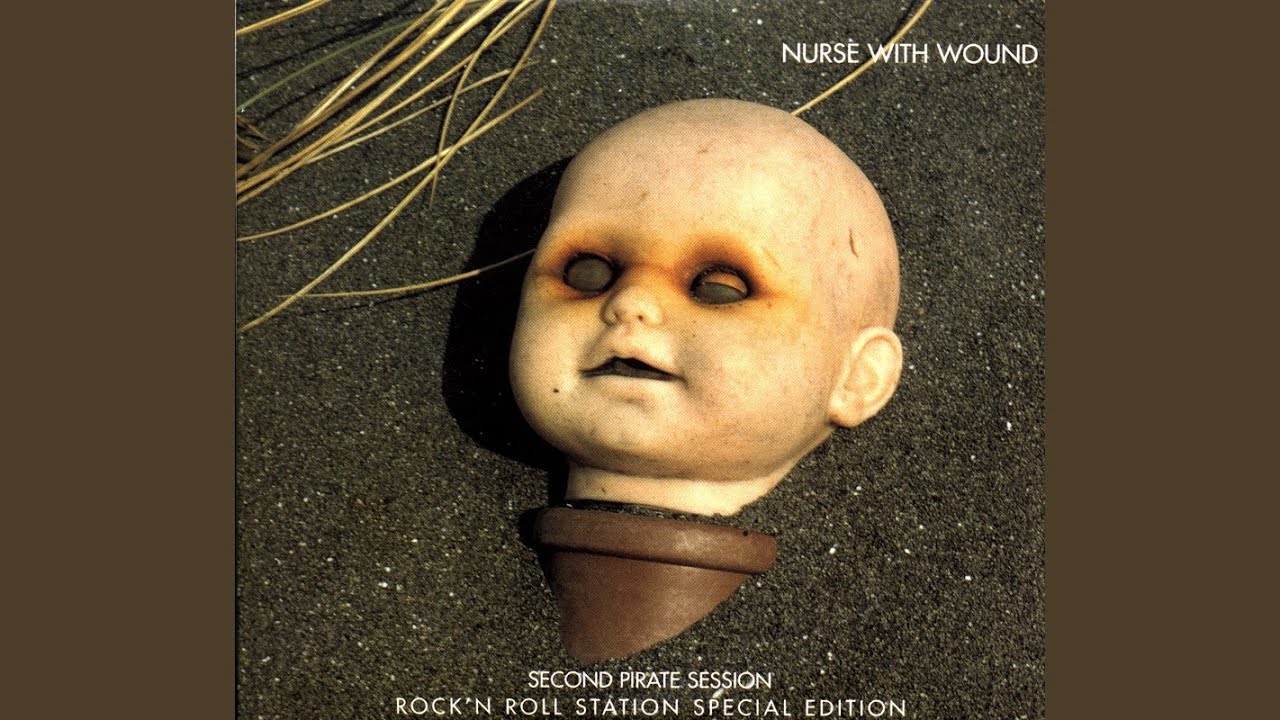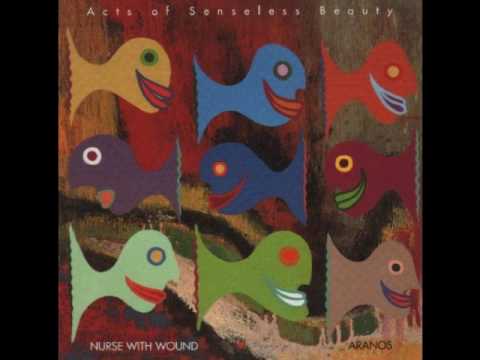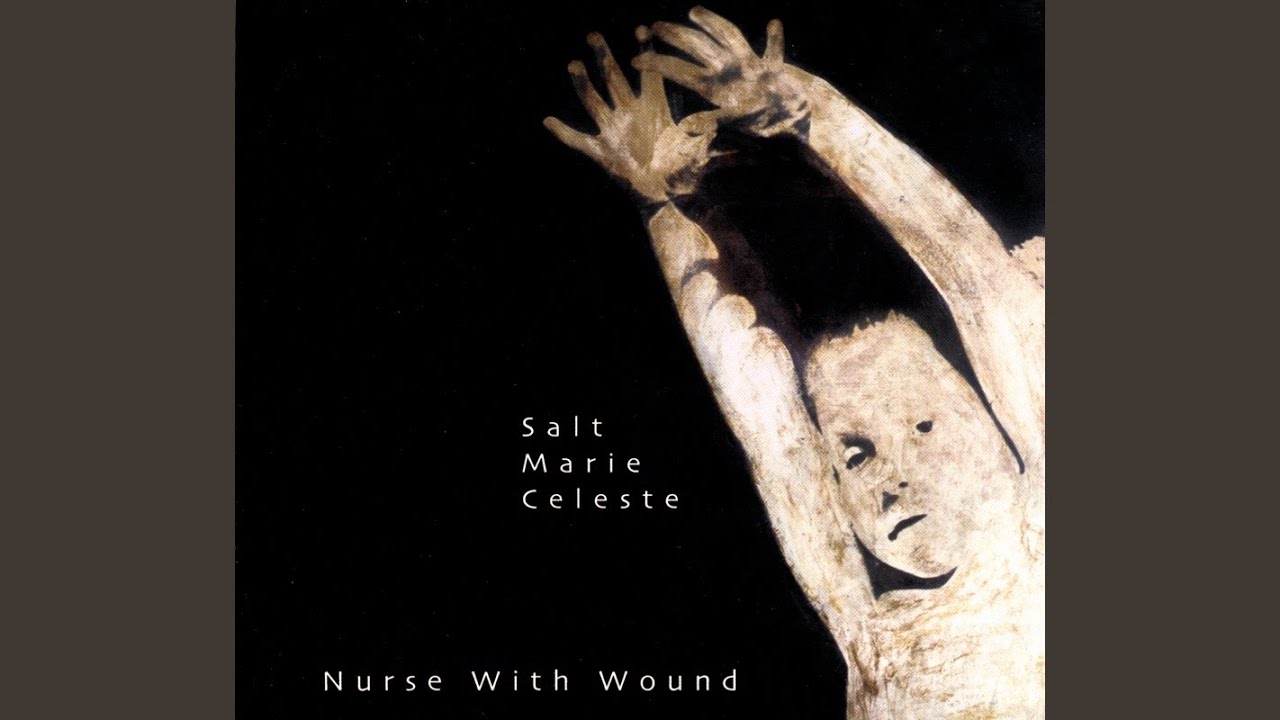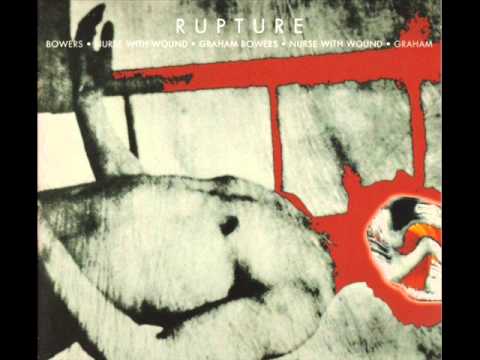If Surrealism’s aim, as art historian Briony Fer put it, is “to reveal the unconscious… and to undo prevalent conceptions of order and reality,” I can think of no other artist than Nurse With Wound who has most successfully transposed the wayward visual art movement into sound. While there are countless recording artists intent on weirdness or aiming for the contrary, very few reach the visionary heights of Steven Stapleton in imposing full-scale oneiric fictions on our waking psyche. Nurse With Wound’s output and methodology wilfully ignores perceived wisdom. Instead, it opts to experiment, to err and be done, as if mining the moment for its hidden channels, to discover pathways that stimulate hitherto unexplored areas of our subconscious.
At the foundations of this strange sound world is a potent trinity: a brimming passion for record collecting, an openness to all sounds and an unbound capacity for invention.
Talking to David Keenan in The Wire in 1997 he explained how he had been fascinated by noises in his youth while in hospital, with nothing better to do than get immersed in its ambience: “You’re lying in bed at night and you’re looking up a darkened hall and there’s the matron sitting there with her light and you can hear her pen scraping, you can hear creaks coming from the beds, patients turning over, beds rattling a bit, someone dropping a utensil ten wards down. The echo, the bare walls…”. Darkness, scrapes, creaks, rattles and echo (as well as a nurse, of course) would all play significant, reprising roles in Stapleton’s compositions.
In the late sixties and early seventies, he developed a penchant for those parts in psychedelic music where the players get to wig-out, their instruments becoming unbridled, veering off course, and would seek out ever lengthier examples. Starting with Velvet Underground’s ‘Sister Ray’ and Amon Düul’s Psychedelic Underground, the growing obsession would lead him to travel Europe, particularly Germany where he stayed with auteur producer Conny Plank and roadied for Guru Guru.
Not being a musician or owning any instruments he’d apparently never had designs on recording. That is until meeting Nicky Rogers, an engineer at the British Marketing Service’s studio, who offered him cheap studio time. The bold results are now legendary and yet were recorded and mixed in a matter of hours. Swiftly gathering friends John Fothergill (a kindred soul who he’d met in a record shop) and Heman Pathak, their edited, unrehearsed improv session became Nurse With Wound’s self-released debut album, 1979’s Chance Meeting On A Dissecting Table Of A Sewing Machine And An Umbrella. They had grabbed and borrowed whatever instruments they could get hold of, with Stapleton confident enough to use any object to hand from the outset – he revealed to Audion magazine in 1994 how “There’s a metal chair and a squeaky chair castor… they’ve been on every single record… I was working as a graphic designer and sign-writer. I was employed by Hipgnosis [where Peter ‘Sleazy’ Christopherson of Throbbing Gristle and, latterly, Coil was working] … to help paint designs for Pink Floyd’s Animals cover… I sat down on this chair. I turned and it squeaked, and you could control it. I got talking, saying that I make experimental music, and that, this chair, the sound it makes is amazing! They laughed a little and, I suppose to humour me, they said ‘Go on, take it away with you – you can have it’, and it’s stayed with me ever since.”
Chance Meeting…’s scribbled, energetic chaos became arguably less notorious than the extensive list they inserted in its sleeve of avant garde and experimental artists from Stapleton’s and Fothergill’s record hunting endeavours, which has since gone on to be regarded as a key reference work in outsider music. Several albums rapidly followed in the wake of this newfound enthusiasm for recording (including collaborations with Foetus’ Jim Thirlwell and Whitehouse’s William Bennett). Although brimming with creativity, they didn’t quite possess the transformational prowess that would come to be expected, as a cult vibe grew up around the mysterious project.
Homotopy to Marie (1982)
Despite it numbering fifth in Nurse With Wound’s unwieldy discography, 1982’s Homotopy To Marie was considered its first ‘true’ release by Stapleton. The recording process was certainly the first to involve just himself, a studio and an engineer – a working model that would often be adopted from hereon. Working with engineer Peter McGhee (recently introduced to him by Bennett), Stapleton nailed down the Nurse With Wound sound with Homotopy.
It opens with a ten minute piece for “13 throats”, whose deep groans, strained rasps and wailing provide the ambience of a Victorian asylum, its close-mic picking up the slurping and smacking of lips as much as their distressed emanations, rendering its audience as inmates in Stapleton’s bedtime bedlam.
Meanwhile, the woozy, languid pulsations of a gong on ‘The Schmürz’ continues to provide a bed for Stapleton’s dreamscapes to this day; a pendulous, hypnotic strategy that leaves the listener vulnerable to sonic attacks to come. Indeed, ‘The Schmürz’s acrobatic, frictive editing sees an arsenal of warped military cadence, showers of white noise, electrical hums, fierce and foreign-tongued female voices, and a big brass band, intercut and fired rapidly right between the ears. Although Stapleton has often decried Nurse With Wound’s bracketing into the emergent, industrial scene of the day, his use of confrontational noises on tracks like ‘The Schmürz’, while deftly deployed with a greater sense of mystery and dynamics, share a transgressive edge with contemporaries such as Throbbing Gristle and Whitehouse.
Spiral Insana (1986)
In the Audion interview, Stapleton acknowledged how on Homotopy he’d "learned how to make the sounds I wanted to hear… how to get really nice things out of the mixing desk. Illusions really, like things that weren’t there on the tape… Many things happen by accident… You kind of build up a repertoire of mistakes… my instrument is a mixing desk."
“The first album I did properly after Homotopy”, he said, was Spiral Insana from 1986, following a rare record deal from Belgian label Torso, thanks to their relationship with Stapleton’s friends in The Legendary Pink Dots. Unlike Homotopy its library of sounds was largely musical with arrays of percussion, funereal church organs, a foreboding bowed piano and a wistful yet warm kosmische synth theme (or something that sounds like one). In addition, there were guitar contributions from Robert Haigh and Chris Wallis, while David Jackman, whose recent LP as Organum saw Stapleton contribute a ‘metal chair’, here returned the favour with some banjo and a ‘splutter’.
Stapleton loops and edits them as if each sound is a character in a complex film, jump cutting from one to other as the action gets more frenetic and disturbing, adding flailing feedback, junk shop clatter, bagpipes, and what could be a symphony of unoiled gates. The mix takes us through introspection and pathos to a feverish madness as if the lead protagonist in this cinema for the ears is grief-struck and, haunted by their memories, loses their mind.
Soliloquy For Lilith (1988)
Stapleton had met his future (now ex) wife, Diana Rogerson, a fellow local artist known for Fistfuck, a S&M performance art duo with Jill Westwood, in 1984 and, by 1988 they had had their first child together, Lilith. Around this time, Rogerson had persuaded Stapleton to give up his day job at an engraving studio to pursue music full time which initially led to the accidental production, Soliloquy For Lilith, dedicated to their daughter. Stapleton recalled its unique instrumentation to Stay Thirsty Media in 2008: “They were in fact guitar pedals linked together. And then the last one fed through to the first one again. So the hum of the pedals would create a loop, and then melodies would be created by just putting my hand, like a theremin, almost touching the wires because they were so sensitive, and it would change the melodies and sound of them. So in a way I didn’t really play it, it just came through the air.”
The novel vibrations weren’t merely incorporated into the next Nurse With Wound audio collage, but formed the sole sound across a triple LP (subsequently expanded to eight sides) such was the rich and varying sonorities it produced. Words fail the fascination and charm the ‘six songs for Lilith’ bear – what was essentially feedback born of an electrical fault, became a music that, though strange as any of Stapleton’s work, is a soothing balm without the frights or eeriness more typical of his oeuvre. Its confident interpolation of Sixties minimalist composition (like that of La Monte Young or Éliane Radigue) pre-dates by a full decade Coil’s Time Machines, which, in turn, is arguably responsible for unleashing today’s deluge of drone.
With such an unworldly, meditative vibe Soliloquy For Lilith went on to become one of Nurse With Wound’s best-selling releases and funded Stapleton and Rogerson’s relocation to a remote goat farm they call Cooloorta in County Clare in the south of Ireland.
The Sadness Of Things with David Tibet (1991)
Stapleton’s chance meeting with David Tibet of Current 93, on the occasion of the notorious Equinox Event of June 1983 (a showcase of Industrial-inclined performers in Camden) would lead to a long-lasting friendship and creative partnership. They met at the pub across the road after Stapleton had angrily decamped there from the venue where a possibly over-exuberant John Gosling (performing at the event with John Balance as Zos Kia) had pissed on him and the front row of the audience. In the pub, Tibet revealed how he was a fan and from hereon the pair would contribute to most of each other’s outputs for years to come.
Upon arriving at The Sadness Of Things, they agreed its release should bill them equally given the balanced inputs from each. A dreamy, intoxicating 31 minute ritual of pagan woodwind and violin from Joolie Wood, it has her wandering tones melt away under fragmentary voices before Tibet briefly laments over the final section. Together, it beautifully presents a solemn meditation on the inevitable sorrow inherent in nature from an eternal perspective.
The Sadness Of Things was also one of Stapleton’s earliest uses of IC Studio, owned by Colin Potter, a sonic experimentalist since the late 70s, whose extensive explorations at the confluence of natural and processed sounds, like those with fellow Yorkshiremen Andrew Chalk and Darren Tate (in Ora and Monos), had a similar surreality to Stapleton’s sound.
Rock ‘N Roll Station (1994)
Potter would quickly become a key player in Nurse With Wound’s productions, a position he continues to fulfil to this day. He was first credited as a member on 1992’s Thunder Perfect Mind, a tour-de-force of cold, at times hostile, machined atmospheres, but considers Rock ‘N Roll Station from the following year to still be his favourite.
Although separated by the Irish Sea, Stapleton and Potter had developed a successful working relationship dividing it into Stapleton’s “things that make noise” and Potter’s “things that change noise”. As Potter explained to David Keenan in England’s Hidden Reverse “What I sometimes did in the studio was to ‘over-use’ effects and processors to totally mutate a piece into something completely different” while Stapleton observed how “it was almost as though telepathic messages were sent over to Colin. [We’d] started an album [together at IC Studio] that was never finished. He [then] sent me some vague mixes, which were just what I had in mind. So, from that basis, I started putting the album together.”
The ensuing record confounded fans’ expectations through its strong focus on rhythm, which was erroneously surmised by some as an attempt to join the then rising electronic dance music scene. But it was Stapleton’s recent obsession with the music of ‘King of the Mambo’ Pérez Prado that was beating at the heart of Rock N’ Roll Station’s heady rhythms.
The album’s title alluded to two specifically rock-related stations of influence: the song of the same name by Jac Berrocal, of which a surprisingly straight cover opens the album in homage; and the tragic life of the Sixties British R&B organist Graham Bond who influenced bands such as Deep Purple and Cream. Beset by mental health problems (at one point believing he was the son of Aleister Crowley), Bond died under a train at a Tube station in 1989 and it is this tragic scene that Rock ‘n Roll Station’s closing track, ‘Finsbury Park, May 8th, 1:35 PM (I’ll See You In Another World)’, sets in sound.
Acts Of Senseless Beauty with Aranos (1997)
The infectious part mamba, part voodoo rhythms that featured on Rock ‘N Roll Station would get reworked on several future releases, including the centrepiece of 1997’s Acts Of Senseless Beauty, Stapleton’s first collaboration with violinist Petr Vastl AKA Aranos. ‘A Window Of Possible Organic Development’ has Aranos’ violin squeaking over ominous chatter and churning tones that lull you into a subconscious setting before the rude wakeup call of the ‘Yagga Blues’ rhythm reconfigured as a wild, shamanic session.
While consistently arriving at the wayward reaches now typical of Nurse With Wound releases, Stapleton’s collaborations with Aranos are perhaps at their most musically coherent. Vastl, born in the Czech Republic but residing in Galway, southern Ireland – not so far from Cooloorta – threads his violin through Stapleton’s recordings to lend them both poise and structure. His versatile playing not only provides the sort of creakiness Stapleton would usually use his chair or other object to achieve, but also adds musical charm like on Acts Of Senseless Beauty’s opening and closing tracks where Vastl’s strings dance elegantly over soft, gamelan-like percussion, with a serene restraint.
Salt Marie Celeste (2003)
With the exception of Soliloquy For Lilith, Salt Marie Celeste is perhaps Nurse With Wound’s simplest and most popular release, and would prove to be the first catalyst in turning Stapleton’s strictly studio-based praxis into today’s live improv unit.
Originally titled ‘Salt’, Potter and Stapleton created its suitably drifting drone mixed with a surging oceanic soundscape as a backdrop to an exhibition of Stapleton’s visual art, displayed jointly with work from Tibet at London’s Horse Hospital in 2002. The unique, hour-long composition uncannily invokes the ghost ship of its title with creaks and rattles served over the ominous, omnipresent threat of the sea with a menacing air and haunting grace.
Such was the success of Salt Marie Celeste, gaining fourth place in The Wire’s albums of the year for 2003, Stapleton was invited to the Netherlands’ Earational Festival in 2004 where he and Potter installed a quadrophonic version of the recording. The following year further opportunities started to arise, initially with performances in Vienna, for which Stapleton recruited Rogerson along with two longstanding fans of Nurse With Wound: Californian artist Matthew Waldron, who had been creating his own audio oddities as irr. app. (ext.) since 1988, and the UK’s prolific aural alchemist Andrew Liles. Having stated that Nurse With Wound could never be a band, Stapleton was confounding his own expectations for once – inspired by Current 93’s determined touring and Coil’s recent and surprising forays into live performance, the years to follow would see the band play out with a strangely reliable regularity.
The Surveillance Lounge (2009)
In 2009, following Stapleton and Potter’s sublime Iron Soul of Nothing, a remix of Sunn O)))’s debut album, Stapleton largely spent his studio time with Andrew Liles (who by then had also taken on most mixing and electronics duties for Current 93’s releases). Their fun-filled ‘easy listening lounge exotica’ album Huffin’ Rag Blues was followed by an album that couldn’t have contrasted more deeply.
The Surveillance Lounge was built from material the pair had developed for a live soundtrack to FW Murnau’s 1922 silent film Der Brennende Acker, an everyday tale of love, death and the property rights of an oil field. On the evidence of The Surveillance Lounge one can’t help feeling that images would be superfluous to its severely intense and disturbing deluge of maddening sound matter.
It’s a tour de force display of Stapleton’s hyperactive editing, as heard previously on albums like The Sylvie & Babs Hi-Fi Companion and Homotopy But, with the benefit of Liles ultra-vivid sound design making space for such high-density compositions, the album’s hour drenches its listeners in unprecedented layers of agitated babble, twisted wails, guttural groans, tortuous ratcheting and the odd glimpse of Andy Williams’ ‘Can’t Take My Eyes Off Of You’ displacing its cheer into a precipitous mix of psychological imbalance.
Rupture with Graham Bowers (2011)
Neurological health would be a subject Stapleton would explore seriously with fellow composer/ painter/ sculptor, Graham Bowers, on 2010’s Rupture. Its “attempt to create a musical illustration of a life after suffering a major stroke” has Stapleton’s skills in collage this time complemented by Bowers’ ongoing interest in using sound as theatre.
It’s three pieces, subtitled ‘…a life as it now is, …is not what it was, …and never will again’, come across like the histrionics of a serialist concerto, depicting a life in danger with bold brass and bombastic percussion getting repeatedly back footed by found sounds and warped effects. The barrage becomes incessant and is occasionally intruded upon by non-musical events such as impatiently ringing telephones to Stapleton’s proprietary layering of plunderphonic voices. The overall effect is, of course, deliberately discombobulating, as if being flung repeatedly and uncontrollably away from consciousness, making for a difficult, although admirably ambitious and artful, listening experience.
The pair would go on to explore other conditions across several albums together before Bowers sadly passed away in 2015.
Dark Fat (2016)
To celebrate a decade of Nurse With Wound’s deranged live shows last year saw the release of the double disk, Dark Fat. Never one to disappoint with the obvious, it is not a live album in the regular sense, but a two-hour mixtape by Stapleton and Waldron formed from recordings of both shows and rehearsals. There are plenty of straight(er) documents of Nurse With Wound performances (from 2006’s Soundpooling to 2014’s Contrary Motion) that capture relatively complete sets in all their chaotic and creative splendour, but Dark Fat somehow manages to be both representative of the Nurse With Wound live experience and a compelling tape collage in its own right. Ably covering the full spectrum of Stapleton’s signature sounds – from concrète cacophonies, through woozy drones, to ritualistic rhythms – at times, it also hints at the Kosmische music that so inspired him.
Although now a band arguably edging a little closer to the rock paradigm than before, Dark Fat demonstrates how after almost 40 years Nurse With Wound remains firmly in a field of its own, in which genuinely unique and seriously addictive sounds are cultivated. And, wherever you land in Steven Stapleton’s galactic back catalogue you will enter a strange world of wonder, where sounds are promoted to the most precious of resources and handled with a palpable love of listening that becomes infectious and whose effect is transformational.
Nurse With Wound appear live this weekend at Tusk Festival, Gateshead






